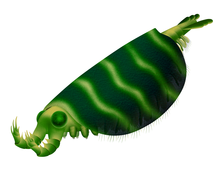| Deuteropoda | |
|---|---|

| |
| Life restoration of Kylinxia zhangi, a basal deuteropod | |

| |
| Life restoration of Surusicaris, a likely basal deuteropod | |
| Scientific classification | |
| Domain: | Eukaryota |
| Kingdom: | Animalia |
| Phylum: | Arthropoda |
| (unranked): | Deuteropoda Ortega-Hernández 2016[1] |
| Subphyla and classes | |
Deuteropoda is a proposed clade of arthropods whose members are distinguished from more basal stem-group arthropods like radiodonts by an anatomical reorganization of the head region, namely the appearance of a differentiated first appendage pair (the 'deutocerebral' pair), a multisegmented head, a hypostome/labrum complex, and by bearing pairs of segmented biramous limbs.[1]
The clade contains all living arthropods (i.e. chelicerates and mandibulates) as well as several fossil groups that share these characteristics (e.g. Fuxianhuiida Megacheira, Isoxyida, and Artiopoda), while excluding other fossil groups that are more 'basal' or 'primitive' (e.g. radiodonts, opabiniids and lobopodians).[1][3] Members of Deuteropda that are basal to the last common ancestor of chelicerates and mandibulates (and thus lie outside the crown group of Arthropoda) are often referred to as "upper stem group arthropods".[1]
- ^ a b c d Ortega-Hernández, Javier (2016), "Making sense of 'lower' and 'upper' stem-group Euarthropoda, with comments on the strict use of the name Arthropoda von Siebold, 1848", Biol. Rev., 91 (1): 255–273, doi:10.1111/brv.12168, PMID 25528950, S2CID 7751936
- ^ McCall, Christian (13 December 2023). "A large pelagic lobopodian from the Cambrian Pioche Shale of Nevada". Journal of Paleontology. doi:10.1017/jpa.2023.63. Retrieved 13 December 2023.
- ^ Budd, Graham E. (2021). "The origin and evolution of the euarthropod labrum". Arthropod Structure & Development. 62: 101048. doi:10.1016/j.asd.2021.101048. ISSN 1467-8039. PMID 33862532.
© MMXXIII Rich X Search. We shall prevail. All rights reserved. Rich X Search
